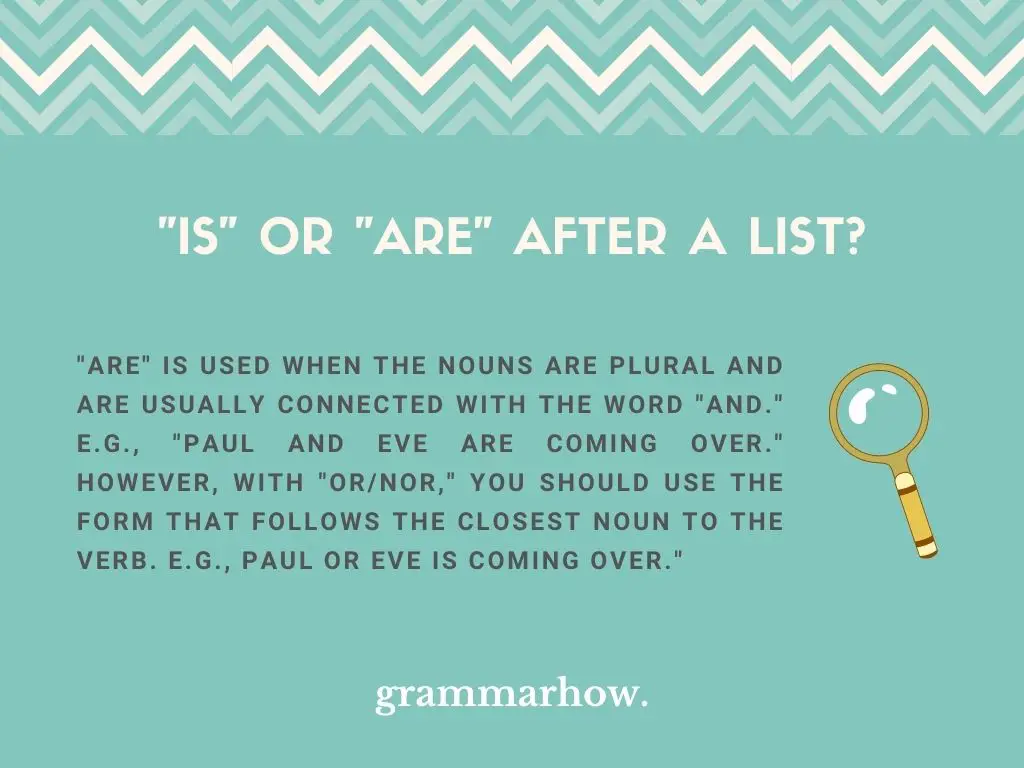Knowing whether to use “is” or “are” after a list of things can be tricky because of the different singular and plural rules.
If you want to know when to place “is” and when to use “are” after two nouns, then keep reading, and this page will explain which one to use.
“Is” or “Are” after a List?
“Are” is used when the nouns are plural and are usually connected with the word “and.” E.g., “Paul and Eve are coming over.” However, with “or/nor,” you should use the form that follows the closest noun to the verb. E.g., Paul or Eve is coming over.”

Using “is” or “are” depends significantly on the word that connects the nouns.
For example, when the things in a list are plural nouns or are connected with “and,” you should usually use “are” because you are referring to a plural quantity.
- Black, red, and green are my favorite colors.
- His apartment and truck are both for sale.
- The apartments and houses are beautiful.
However, when the objects on the list are connected with “or” or “nor,” whether to use “is/are is decided by the closest thing to the verb.
When it is singular, use “is,” and when it is plural, use “are.”
- Neither my sister nor my parents are coming with us. (Plural is closest)
- Neither my parents nor my sister is coming with us. (Singular is closest)
- Either my sister or my parents are going to help me move. (Plural is closest)
- Either my parents or my sister is going to help me move. (Singular is closest)
You can also connect objects on a list with other words except for “and,” “or,” and “nor.”
Now that we have established the basics of using “are” and “is” after a list, keep reading to discover how to use “is” and “are” with other words that connect things on a list.
When to Use “Is” after a List
We have broken down when you should use “is” after a list into several sections.
The first is when the items on the list are connected by “or/nor,” and the closest object to “is/are” is singular.
- I think my husband or colleagues are willing to help.
- I think my colleagues or husband is willing to help.
The second is when the two nouns preceding “is/are” are regarded as a “single item” despite being two separate items.
- A name and address is all we need to sign up new customers.
- Fish and chips is his favorite meal.
Thirdly, when a list starts with the words “every” or “each,” you should use the singular “is.”
- Every man, woman, and child is welcome to participate in the celebrations.
- Each teacher and student is required to complete an assessment of each other.
Lastly, if you connect the list with “as well as,” the choice of whether to use “is/are” is decided by the first item on the list rather than the one closest to it.
- My brother, as well as my parents, is coming over for dinner.
- Loud sirens, as well as an alarm, alert the students of earthquakes.
When to Use “Are” after a List
When the nouns are plural, you should use “are” after the list.
- Apples, cherries, and blueberries are in this pie.
- Adults and children are welcome.
However, with the connectors “or/nor,” if the closest item to “is/are” is singular, you must use “is.”
- My brother or friends are picking us up later.
- My friends or my brother is going to pick us up later.
Another frequent time you will use the word “are” after a list is when the items on the list are connected by the word “and,” so they form a plural quantity.
- Sue and George are moving house.
- Chinese and Indian are my favorite cuisines.
However, there are certain exceptions to this rule, and some nouns connected by “and” are thought of as one item. In these cases, you should use “is and not “are.”
- A gin and tonic is what you need.
- His name and address is inside his wallet.
- Chicken and rice is his specialty.
Conclusion
The term “is” should be used after lists that contain “or/nor” when the closest item is singular. E.g., “My parents and friend are coming for dinner.”
Also, for items viewed as a single unit, such as “bacon and eggs,” use “is.”
In contrast, “are” is used for plural nouns or quantities, which you usually connect with the word “and.”

Martin holds a Master’s degree in Finance and International Business. He has six years of experience in professional communication with clients, executives, and colleagues. Furthermore, he has teaching experience from Aarhus University. Martin has been featured as an expert in communication and teaching on Forbes and Shopify. Read more about Martin here.
